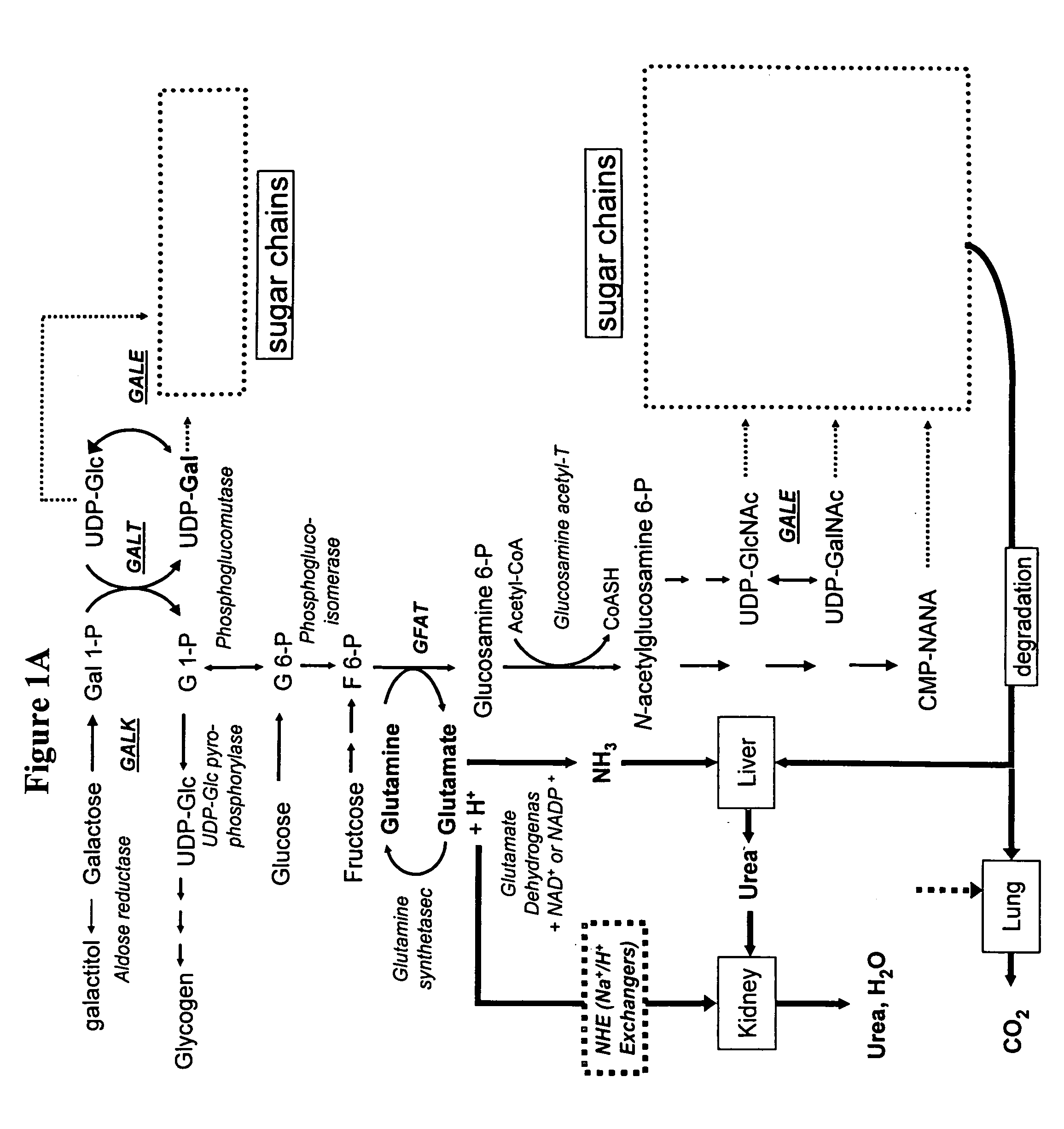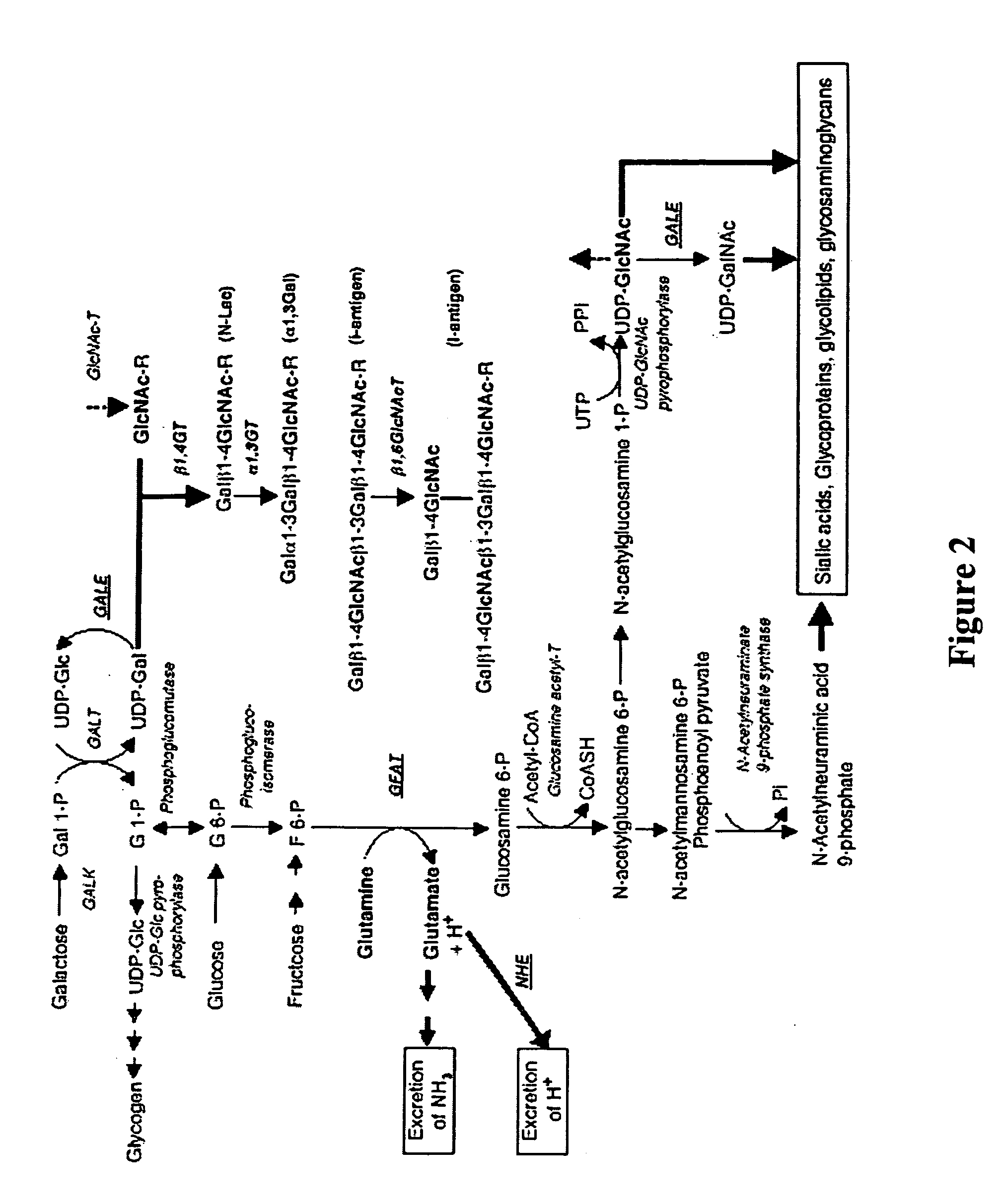Modification of sugar metabolic processes in transgenic cells, tissues and animals
a technology of transgenic cells and metabolic processes, applied in the direction of biochemistry apparatus and processes, transferases, enzymology, etc., can solve the problems of difficult to predict how changing the activity of a single enzyme will affect the entire reaction pathway, ammonia can be toxic, mild irritation, etc., to reduce the accumulation of toxic sugar metabolites, and prevent the effect of galactose transpor
- Summary
- Abstract
- Description
- Claims
- Application Information
AI Technical Summary
Benefits of technology
Problems solved by technology
Method used
Image
Examples
example 1
The Effect of a Galactose-Rich Diet and Carbon Dioxide Exposure on α1,3GT Knockout Mice
[0256] To elucidate the underlying mechanism(s) of the galactosemia, as measured by the formation of early onset cataracts (EOC), in the α1,3GT-knock-out (KO) mouse, the influence of a) a galactose-rich diet and b) carbon dioxide (CO2) exposure on the 129 SV α1,3GT was studied.
[0257] The α1,3GT-double knockout mice exhibited EOC soon after weaning, however, the EOC was slight, generally being of a pinhead size (FIG. 26-a). Wild type (WT) and the α1,3GT-double knockout mice were divided into 4 groups (n=10, each). Each group was fed either galactose-rich diet (40, 20, or 10% galactose) or normal diet (4.5% galactose). No cataract formation was observed in the WT mice even at the 40% diet level. The cataract size in the α1,3GT-double knockout mice remained the same regardless of the galactose concentration.
[0258] However, long term feeding of a galactose-rich diet resulted in systemic impairment....
example 2
Evolution of α-1,3-GT in Higher Primates
[0264] The α1,3-galactosyltransferase (α1,3GT) gene (Blanken, W. M et al. J. Biol. Chem. 260, 12927-12934 (1985)) was inactivated 23 MYA, contemporaneous with higher primate emergence (Glazko, G. V. et al. Mol. Biol. Evol. 20, 424434 (2003)). Alignment of the active gene and unprocessed and processed α1,3GT pseudogenes of multiple αGal-positive and negative species allowed reconstruction of 4 protogenes thought to have been expressed successively between 56-23 MYA. Throughout this period, selection pressure on the enzyme's stem region favored expression for prevention of intra-Golgi UDP-galatose accumulation. α1,3GT inactivation apparently occurred when glycoconjugate enzyme(s) substituted for this housekeeping function, allowing other changes that powerfully propelled speciation. The inactivation was thereby causal in higher primate emergence.
[0265] The α1,3Gal epitope is expressed at the surface of cells of essentially all lower mammals an...
PUM
| Property | Measurement | Unit |
|---|---|---|
| Volume | aaaaa | aaaaa |
| Volume | aaaaa | aaaaa |
| Volume | aaaaa | aaaaa |
Abstract
Description
Claims
Application Information
 Login to View More
Login to View More - R&D
- Intellectual Property
- Life Sciences
- Materials
- Tech Scout
- Unparalleled Data Quality
- Higher Quality Content
- 60% Fewer Hallucinations
Browse by: Latest US Patents, China's latest patents, Technical Efficacy Thesaurus, Application Domain, Technology Topic, Popular Technical Reports.
© 2025 PatSnap. All rights reserved.Legal|Privacy policy|Modern Slavery Act Transparency Statement|Sitemap|About US| Contact US: help@patsnap.com



